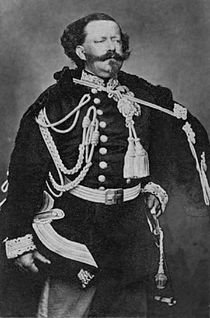

politician
14 March 1820 Palazzo Carignano, Turin, Kingdom of Sardinia
9 January 1878(1878-01-09) (57) Quirinal Palace, Rome, Kingdom of Italy
NamesItalian: Vittorio Emanuele Maria Alberto Eugenio Ferdinando Tommaso English: Victor Emmanuel Mario Albert Eugene Ferdinand Thomas
Italian politician, king of Sardinia-Piemont and Italy Vittorio Emanuele IIVictor Emmanuel c. 1861, by DisdériKing of Italy (more...) Reign17 March 1861 – 9 January 1878 PredecessorNapoleon (1814)SuccessorUmberto IPrime Ministers See list Camillo CavourBettino RicasoliUrbano RattazziLuigi Carlo FariniMarco MinghettiAlfonso Ferrero la MarmoraLuigi Federico MenabreaGiovanni LanzaAgostino Depretis King of SardiniaReign23 March 1849 – 17 March 1861PredecessorCharles AlbertPrime Ministers See list Agostino ChiodoClaudio Gabriele de LaunayMassimo D'AzeglioCamillo CavourAlfonso Ferrero La Marmora Born14 March 1820 Palazzo Carignano, Turin, Kingdom of SardiniaDied9 January 1878(1878-01-09) (aged 57) Quirinal Palace, Rome, Kingdom of ItalyBurialPantheon, RomeSpouse Adelaide of Austria (m. 1842; died 1855) Rosa Vercellana (m. 1869) Issue see details... Maria Clotilde, Princess Napoléon Umberto I of Italy Amadeo I of Spain Oddone, Duke of Montferrat Maria Pia, Queen of Portugal NamesItalian: Vittorio Emanuele Maria Alberto Eugenio Ferdinando Tommaso English: Victor Emmanuel Mario Albert Eugene Ferdinand Thomas HouseSavoyFatherCharles Albert of SardiniaMotherMaria Theresa of AustriaReligionRoman CatholicismSignature Victor Emmanuel II (Italian: Vittorio Emanuele II; full name: Vittorio Emanuele Maria Alberto Eugenio Ferdinando Tommaso di Savoia; 14 March 1820 – 9 January 1878) was King of Sardinia from 1849 until 17 March 1861, when he assumed the title of King of Italy and became the first king of a united Italy since the 6th century, a title he held until his death in 1878. Borrowing from the old Latin title Pater Patriae of the Roman emperors, the Italians gave him the epithet of Father of the Fatherland (Italian: Padre della Patria). Born in Turin as the eldest son of Charles Albert, Prince of Carignano, and Maria Theresa of Austria, he fought in the First Italian War of Independence (1848–1849) before being made King of Piedmont-Sardinia following his father's abdication. He appointed Camillo Benso, Count of Cavour, as his Prime Minister, and he consolidated his position by suppressing the republican left. In 1855, he sent an expeditionary corps to side with French and British forces during the Crimean War; the deployment of Italian troops to the Crimea, and the gallantry shown by them in the Battle of the Chernaya (16 August 1855) and in the siege of Sevastopol led the Kingdom of Sardinia to be among the participants at the peace conference at the end of the war, where it could address the issue of the Italian unification to other European powers. This allowed Victor Emmanuel to ally himself with Napoleon III, Emperor of France. France had supported Sardinia in the Second Italian War of Independence, resulting in liberating Lombardy from Austrian rule. Victor Emmanuel supported the Expedition of the Thousand (1860–1861) led by Giuseppe Garibaldi, which resulted in the rapid fall of the Kingdom of the Two Sicilies in southern Italy. However, Victor Emmanuel halted Garibaldi when he appeared ready to attack Rome, still under the Papal States, as it was under French protection. In 1860, Tuscany, Modena, Parma and Romagna decided to side with Sardinia-Piedmont, and Victor Emmanuel then marched victoriously in the Marche and Umbria after the victorious battle of Castelfidardo over the Papal forces. He subsequently met Garibaldi at Teano, receiving from him the control of southern Italy and becoming the first King of Italy on 17 March 1861. In 1866, the Third Italian War of Independence allowed Italy to annex Veneto. In 1870, Victor Emmanuel also took advantage of the Prussian victory over France in the Franco-Prussian War to conquer the Papal States after the French withdrew. He entered Rome on 20 September 1870 and set up the new capital there on 2 July 1871. He died in Rome in 1878, and was buried in the Pantheon. The Italian national Victor Emmanuel II monument in Rome, containing the Altare della Patria, was built in his honor.

We use cookies
We use cookies and other tracking technologies to improve your browsing experience on our website, to show you personalized content and targeted ads, to analyze our website traffic, and to understand where our visitors are coming from. Privacy Policy.